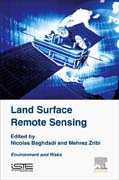
Land Surface Remote Sensing: Environment and Risks
Baghdadi, Nicolas
Zribi, Mehrez
Land Surface Remote Sensing: Environment and Risks explores the use of remote sensing in applications concerning the environment, including desertification and monitoring deforestation and forest fires. The first chapter covers the characterization of aerosols and gases by passive remote sensing. The next chapter presents the correlation of optical images for quantifying the deformation of the Earth's surface and geomorphological processes. The third chapter is examines remote sensing applications in the mining environment. The fourth chapter depicts the strong potential of radar imagery for volcanology and urban and mining subsidence studies. The next two chapters deal respectively with the use of remote sensing in locust control and the contribution of remote sensing to the epidemiology of infectious diseases. In the last ten years, spatial observation of the Earth-particularly continental surfaces-has expanded considerably with the launch of increasing numbers of satellites covering various applications (hydrology, biosphere, flow of surface, snow, ice, landslide, floods). This has paved the way for an explosion in the use of remote sensing data. This book offers essential coverage of space-based observation techniques for continental surfaces. The authors explore major applications and provide a corresponding detailed chapter for the physical principles, physics of measurement, and data processing requirements for each technique, bringing you up-to-date descriptions of techniques used by leading scientists in the field of remote sensing and Earth observation. Provides clear and concise descriptions of modern remote sensing methodsExplores the most current remote sensing techniques with physical aspects of the measurement (theory) and their applicationsProvides chapters on physical principles, measurement, and data processing for each technique describedDescribes optical remote sensing technology, including a description of acquisition systems and measurement corrections to be made INDICE: Chapter 1: Dry Regions and Desertification Chapter 2: Remote sensing and measuring deforestation Chapter 3: Remote sensing of vegetation fires Chapter 4: Characterization of human effluent gases and aerosols Chapter 5: Optical Image Correlation: a tool for the quantification of earth motion area and the investigation of tectonic and geomorphologic processes Chapter 6: Application of optical remote sensing for monitoring environmental impacts of the mine, operating at the mine after Chapter 7: SAR data: An asset for volcanology and subsidence studies Chapter 8: Remote sensing serving Locust Chapter 9: Remote sensing applied to the epidemiology of infectious diseases: examples.
- ISBN: 978-1-78548-105-5
- Editorial: ISTE Press - Elsevier
- Encuadernacion: Cartoné
- Páginas: 300
- Fecha Publicación: 01/09/2016
- Nº Volúmenes: 1
- Idioma: Inglés
